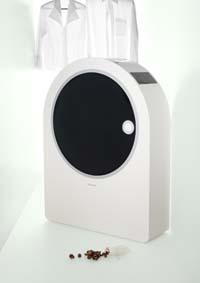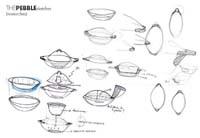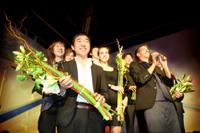This year's winner, the washing machine "clean"

This year's winning design meets these requirements. In fact, the Hungarian student Levente Szabó, from Moholy-Nagy University, has won the first prize thanks to a small washing machine. It has called e-wash to its design and has a simple and clear appearance. Even cleaner is the detergent you use: the soap nut.
The soap nut is the fruit of the mucorossi plant Sapindus, which for centuries has been used by nepales and Indians for cleaning clothes. According to Szabó, a kilo of soap nuts is enough to wash the clothes a person uses for a year. Take good care of the clothes, as it does not remove the color and leaves them gently, easily ironed. In addition, it does not produce allergies. It also serves to clean the body and hair and to cure psoriasis, eczema and other skin conditions in India.
Thus, Szabó has designed a washing machine that replaces traditional detergents with soap nuts. His concern about the environmental impact of the production, transport and use of detergents has seemed to him an adequate solution to solve this problem. He says that “the soapy nut does not harm nature, but is part of it.” Since the soap nut bush is originally oriental, in addition to boosting local trade, it proposes planting it where necessary, thus reducing the environmental impact of transport.
It is the appearance of washing machines as another problem. They are usually quite large and take up a lot of space. It has also been fixed on it, so that the washing machine you have designed is much smaller and thinner than usual. However, he is ever able to wash clothes a lot.
Kitchen and refrigerator
The second prize went to Laura Pandell of the Faculty of Boulle in France for her solar kitchen Pebble. Pandell has shown that to take advantage of solar energy it is not essential to place large solar panels on the roofs of houses, but can also be applied to small things.

It has used photovoltaic spray cells. This technology, still in development, converts infrared waves emitted by the Sun into electric energy. Like the paint, it is placed on the necessary surface by a spray that allows to feed small appliances with solar energy even on cloudy days.
In this case, Pandell has applied this new technology to a small portable kitchen that uses induction heat. In his opinion, modern kitchens are impractical, take up a lot of space and also have to always be in the same place. For its part, Pebble is easily transportable from one place to another and, taking advantage of solar energy, is less harmful to the environment than conventional kitchens.
The winner of the third prize was He Cheg Fei, from Jiangnan University of China. He has manufactured a refrigerator based on the beehive design he has called Go Fresh. Each product is stored in a cell at the required temperature. This saves energy as not all foods need much cold for conservation.
According to He Cheng Fei, “the design of refrigerators has hardly changed since the 1950s. I have tried to redesign. The result is a low energy consumption fridge totally new in its appearance: a large closet type appliance has been replaced by a beehive-shaped design that can be arranged as desired. The cells, in addition to placing them and removing them in the desired way, can be moved from one to the other, even outside the house, and placed one above the other can be used, for example, to distribute the interior spaces of the house.
Other designs

The other five finalists, coming from Thailand, Brazil, Germany, South Korea and the United States, respectively, presented a leftover organic matter composter at home, a tap that only uses two liters of water in the shower, a dishwasher that saves water and detergent, a window cleaning and cooling the interior air of the home and a plastic compostador based on PLA.
All these designs will not be marketed for the moment. The initial goal of the contest is not that, but to encourage creativity and concern for the environment. However, some of the advances they have presented may be on the street within a few years for the benefit of the environment. At what price? This will surely be decided by Elektrolux, in short, the work is done by young students, but the market comes with the name of other brands of Zanussi, AEG or Elektrolux.
Published in Gara
Buletina
Bidali zure helbide elektronikoa eta jaso asteroko buletina zure sarrera-ontzian











